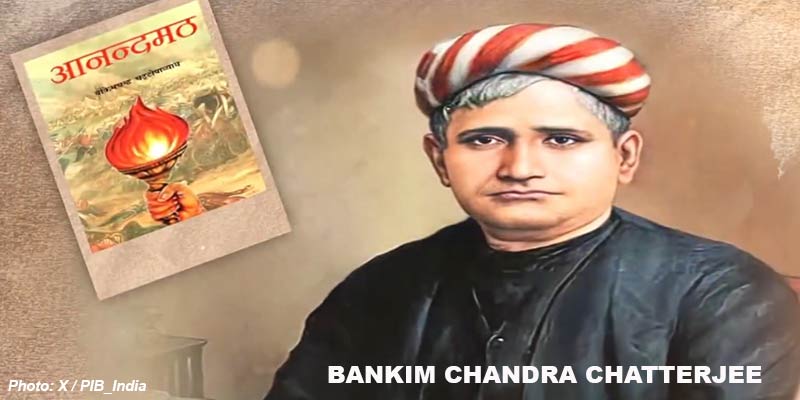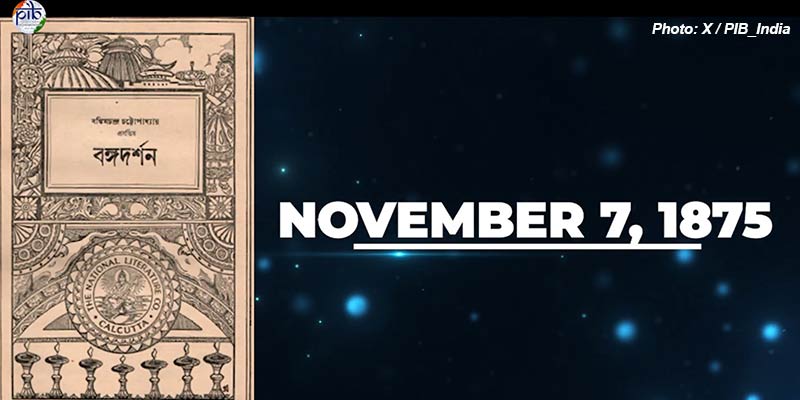- India
- Nov 07
- Sreesha V.M
150 years of ‘Vande Mataram’ song
• Prime Minister Narendra Modi inaugurated a year-long commemoration of ‘Vande Mataram’ to mark 150 years of the National Song.
• He also released a commemorative stamp and coin on the occasion at the Indira Gandhi Indoor Stadium in New Delhi on November 7.
• Written by Bankim Chandra Chatterjee, ‘Vande Mataram’ — which translates to “Mother, I Bow to Thee” — was first published in the literary journal ‘Bangadarshan’ on November 7, 1875.
• Later, Bankim Chandra Chatterjee incorporated the hymn in his novel ‘Anandamath’.
• ‘Vande Mataram’ was sung at the 1896 session of the Congress by Rabindranath Tagore.
• This composition, an enduring anthem, has inspired countless generations of freedom fighters and nation builders, standing as a lasting emblem of India’s national identity and collective spirit.
• It has become an integral part of the nation’s civilisational, political and cultural consciousness.
Bankim Chandra Chatterjee
• Bankim Chandra Chatterjee (1838-1894) was one of the most prominent figures of 19th-century Bengal.
• He holds a pivotal role in the intellectual and literary history of Bengal during the 19th century.
• As a distinguished novelist, poet, and essayist, his contributions significantly influenced the development of modern Bengali prose and the articulation of an emerging Indian nationalism.
• His notable works, including ‘Anandamath’ (1882), ‘Durgeshnandini’ (1865), ‘Kapalkundala’ (1866), and ‘Devi Chaudhurani’ (1884), reflect the social, cultural, and moral concerns of a colonised society striving for self-identity.
• The composition of ‘Vande Mataram’, is recognised as a milestone in nationalist thought, symbolising the synthesis of devotion to the motherland and spiritual idealism.
• ‘Anandamath’ was serialised in the Bengali monthly magazine ‘Bangadarshan’, of which Chatterjee was the founder editor.
• The song ‘Vande Mataram’ appeared in the very first instalment of the serialisation of the novel in the March-April 1881 issue.
• The central plot of the novel ‘Anandamath’ revolves around a group of Sanyasins known as Santanas (meaning children), who dedicate their lives to the cause of their motherland. They venerate the motherland personified as the mother goddess. Their devotion is solely to their land of birth.
• It stood as the symbol of the “religion of patriotism” that was the central theme of ‘Anandamath’.
• Through his writings, Bankim Chandra Chatterjee not only enriched Bengali literature but also laid the foundational ideological principles for India’s early nationalist movement.
Battle cry for resurgent nationalism
• In October 1905, a Bande Mataram Sampradaya was founded in North Calcutta to promote the idea of the motherland as a mission and a religious passion.
• Every Sunday, the members of the society went out in Prabhat Pheris, singing ‘Vande Mataram’ and accepting voluntary contributions from the people in support of the motherland.
• Rabindranath Tagore also sometimes joined the Prabhat Pheris of the Sampradaya.
• On May 20, 1906, in Barisal (now in Bangladesh), an unprecedented Vande Mataram procession took place, with over 10,000 participants marching through the main streets of the town carrying Vande Mataram flags.
• In August 1906, an English daily named ‘Bande Mataram’ was launched under the editorship of Bipin Chandra Pal, with Sri Aurobindo later joining as joint editor.
• Fearlessly preaching the gospel of nationalism, inspiring young Indians to rise above colonial subjugation, the ‘Bande Mataram’ daily served as a major platform for articulating nationalist thought and mobilising public opinion.
• Alarmed by the rising influence of Vande Mataram — both as a song and slogan — the British administration adopted stringent measures to curb its spread.
• The government of the newly created province of Eastern Bengal issued circulars prohibiting the singing or chanting of ‘Vande Mataram’ in schools and colleges.
• The song ‘Vande Mataram’ became the emblem of India’s struggle for independence, encapsulating the collective aspiration for self-governance and the emotional connection between the populace and their homeland.
• Initially popularised during the Swadeshi and anti-partition movements, it quickly transcended regional barriers to serve as the anthem of national awakening.
• From Bengal’s streets to Bombay’s core and Punjab’s plains, the refrain of ‘Vande Mataram’ echoed as a symbol of resistance against colonial rule.
• Leaders, students, and revolutionaries drew motivation from its verses, reciting it at political assemblies, demonstrations, and prior to incarceration.
National Song
• On January 24, 1950, Dr. Rajendra Prasad addressed the Constituent Assembly, stating that ‘Vande Mataram’, due to its significant role in the freedom movement, should have the same status as the National Anthem, ‘Jana Gana Mana’, and be honored equally.
• His statement was adopted with Rabindranath Tagore’s ‘Jana Gana Mana’ being adopted as the National Anthem of independent India, and Bankim Chandra Chatterjee’s ‘Vande Mataram’ being adopted as the National Song.
(The author is a trainer for Civil Services aspirants.)


